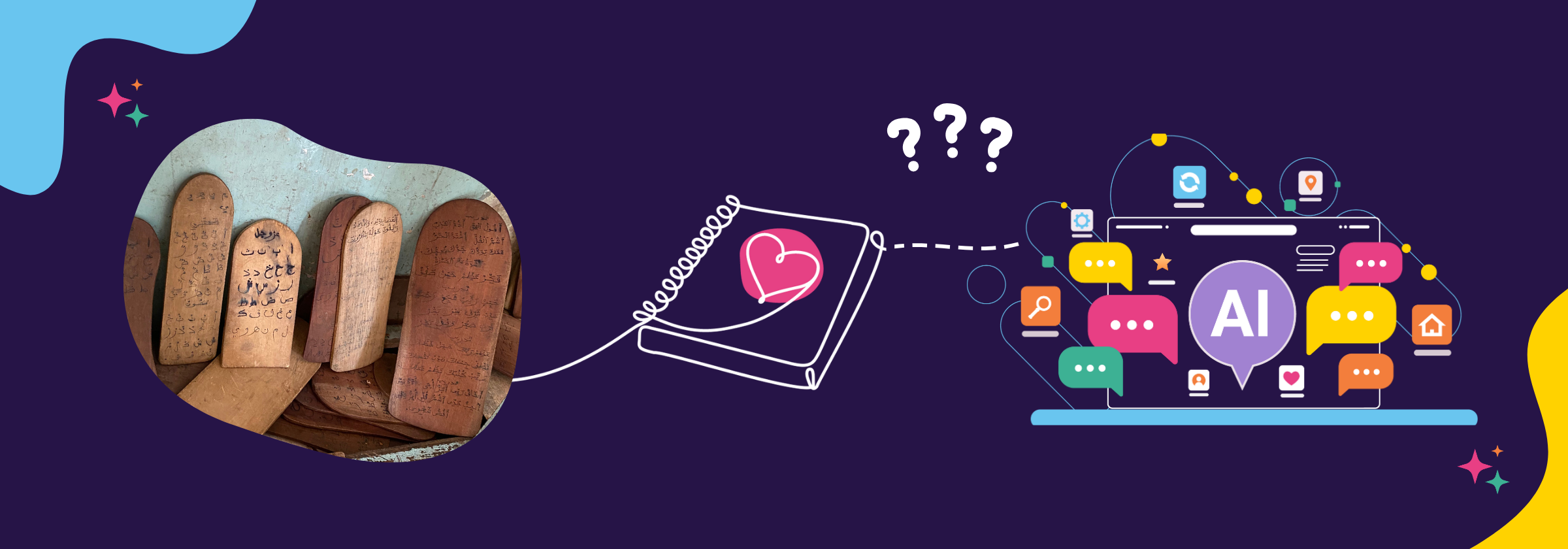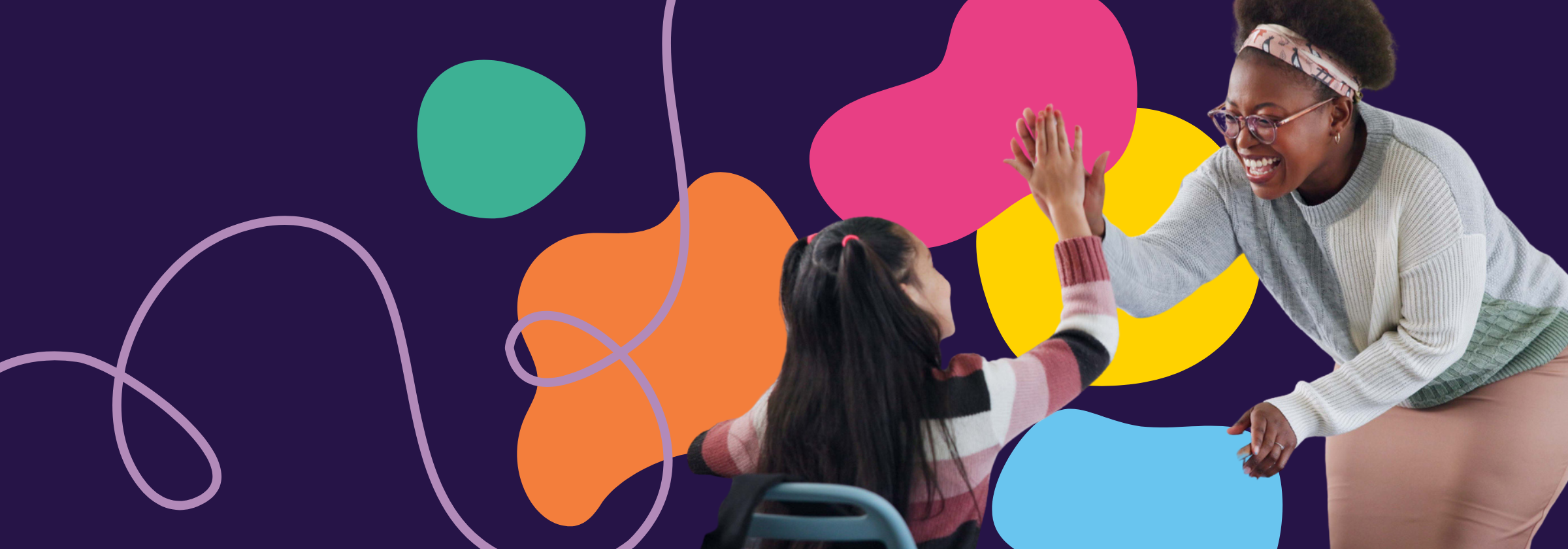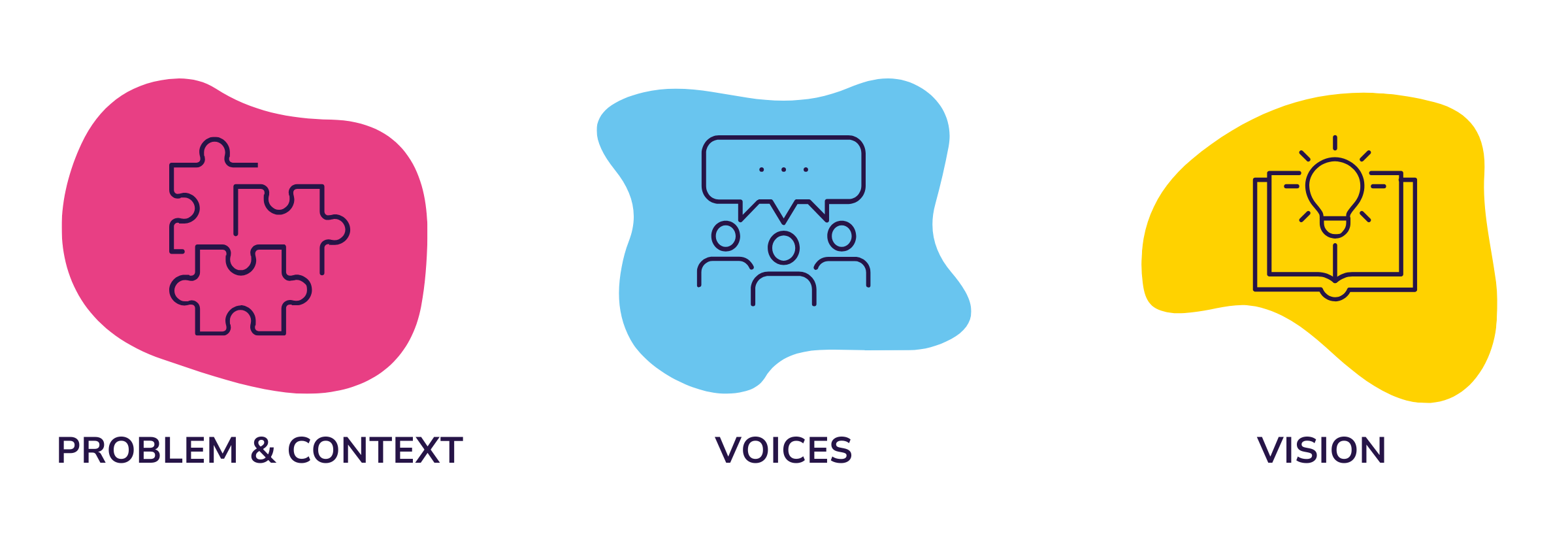From Wooden Tablets to AI: Preserving the Heart of Teaching Across Generations & Innovations
by Malika Ali

As a child, my father learned by lawh — a wooden tablet which housed his lessons. In our village in East Africa, he would visit a carpenter to cut him a piece of wood, then journey to the mountain for limestone which, when moistened and applied to the tablet, formed a film on which lessons could be inscribed. He would walk to the Red Sea to gather shells as inkwells, line them with cloth, and fill them with a mixture of ash from cooking pots, water, and Arabic gum. Cross-legged on the floor along with his classmates and teacher, he was tasked with meaning-making. It was not until he presented back his evidence of internalization and application that he could wipe the lawh and receive his next lesson.
His learning helped him develop self-awareness along with intellectual and character development. Lessons were personalized, delivered whole group, small group, and 1:1, self-paced with parameters, and students demonstrated mastery through performance tasks. When a student reached a milestone, the lawh became a canvas of celebration, adorned and displayed as classmates and community gathered to witness and share in his joy.
As a child I, too, sat cross-legged on the floor, immersed in the same indigenous pedagogical traditions, though, equipped with paper and pencil, I was spared the pilgrimages to mountain and sea. After nearly two decades as an educator, I continue to weave these ancestral practices into the way I teach, coach, and facilitate. Because the industrial model of education continues to threaten our children's joy and genius, my work aims to repair this harm through professional development and leadership coaching centered on inclusive design, system coherence, and justice-oriented processes for continuous improvement.
Core Beliefs

Several core beliefs guide the professional development team I lead at Throughline Learning. We believe that students will be successful when learning experiences:
- leverage their identities and values as strengths
- nurture their academic mindsets
- develop their cognitive skills, and
- support them to apply their learning in meaningful ways that improve their world.
We collaborate with educators and leaders to learn and practice research-based strategies rooted in culturally responsive and sustaining pedagogy, the science of learning, and the development of mindsets and motivations. Over the past fifteen years, we have found opportunities to leverage new technologies in service of our instructional priorities and core beliefs, playing a key role as a facilitator and guide in the early days of the blended learning and personalization movements.
Today, public discourse in education centers on Artificial Intelligence (AI).
Though I claim no expertise in this domain, I do have expertise in pedagogy and policy, and I feel compelled to bear witness to this moment and express what’s at stake for our youth and educators. Teaching and learning should always be a practice of love and care, centering human connection and inspiration. Our duty as educators is to work to know students holistically, affirm their humanity, build on strengths, and remove barriers to self-actualization. Consequently, our recent experiments with AI have elevated questions within our team around relationship-building, safety, privacy, accuracy, reliance, cognitive development, and family and community engagement.
As a former high school science teacher grounded in enduring pedagogical traditions along with an eye toward innovation, I recognize that these questions can only be answered through deliberate experimentation alongside educators, families, and communities. Our communities should be envisioning the kind of world we want, and, as leaders, it is our job to design alongside our communities. So to manage innovations, we begin with our core beliefs and from there we generate design principles that are operationalized into tangible tools and processes.
Design Principles

In Partnership with Playlab.ai, a nonprofit organization devoted to supporting educators and students to use and shape the use of AI, we set out to create a tool to support our educators to craft engaging, relevant lessons that build both mindset and cognitive skills.
As you consider your design principles in alignment with your beliefs, consider these three key questions:
1. What problem are we trying to solve and within what context?
We sought to improve small-group tier 2 support and a staffing model that empowered paraprofessionals and other community educators to mentor and tutor students. We trained educators on our pedagogical framework and a math or literacy platform, supported them to articulate a vision for work with kids, and coached them to leverage data, instructional practices, high-quality curriculum, and technology to accelerate students’ learning.
2. Whose voices are important to elevate in identifying a solution?
We prioritized perspectives from these educators along with the leaders who support them and the students using these tools.
3. What is our vision for excellent teaching and learning?
We ensured that the tool aligned to our core beliefs about the role AI should play in this solution:
- Understanding: Get to know our students better — who they are, what they care about, what their strengths are, and where they need support
- Engagement: Integrate student interests, identities, strengths, and needs to make learning more meaningful and effective for them
- Rigor: Help build student capacity to persevere through learning challenges and develop and measure durable skills, cognitive skills, and social emotional competencies
- Agency: Improve students’ use of self-directed learning moves
Operationalizing Our Principles
Based on these design principles, we built and tested a prototype with educators that leverages our instructional framework and abides by student privacy laws, including FERPA and COPPA. Here’s how one paraprofessional used it to build her tutoring lesson:
She shares relevant information — aspects of her students' interests, identities, and learning profiles — to ensure relevance and differentiation. Based on this information and data from Throughline's validated Student Experience Survey, she reviews insights and recommendations from domains like belonging, academic mindset, and cognitive moves. The tool then prompts her to share where she wants to concentrate.
She selects focus areas for whole-group improvement, receiving tailored strategies with options to refine them based on her context. She digs deeper into one student's scores, gaining targeted strategies to improve his academic mindset and cognitive skills based on his survey responses.
Though this is her first time using the tool, she now has a comprehensive plan that aligns with her math objectives, includes differentiated strategies, deepens her understanding of student needs, and builds her confidence in teaching relevant, engaging, rigorous, differentiated lessons. She gets to spend most of her time thinking critically and creatively to ensure her students are developing the most important skills, and she is excited about empowering them as self-directed learners. She hugs me and says she can't wait to teach the lesson!
Looking Forward
This experiment leaves me hopeful, though I still grapple with collective concerns around bias, inaccuracy, overreliance, and security. For this reason, we couple AI tools with professional development that empowers educators to be critical consumers and designers. I believe our community can navigate these challenges by establishing appropriate guidelines and guardrails, so long as we remain anchored in our beliefs, committed to inclusive design principles that prevent harm and empower communities, and operationalize these principles with equity at the center and continuous improvement guiding our path.
My father could never have envisioned these sorts of teaching tools, nor could I. But as I imagine the learning environments that might emerge in my lifetime, I hope certain elements of good teaching — those my father experienced in our village in East Africa — will endure: supporting kids to know themselves, personalizing lessons, balancing whole and small group, flexible pacing, meaningful performance tasks, effective use of holistic data, celebration of learning, and, most importantly, teaching as a practice of love.
Learn More
At Throughline Learning, we know that effective instruction will always be about human interaction. If you’re looking to establish thoughtful safeguards and boost your educators’ capacity, confidence, and creativity in this new era of immense possibilities, visit our Fuse AI page to learn more about our Fellowship and professional learning offerings related to AI.
About the Author
As the Chief Innovation Officer at Throughline Learning (formerly Highlander Institute), Malika Ali leads program visioning, R&D, and implementation for school, district, and state partners. Through her work, she was named one of the nation’s top emerging and inspirational Black leaders in education. In addition, as a former high school science teacher, Malika was a Rhode Island District Teacher of the Year and served on the governor’s STEAM and Equity in Educator Preparation Working Group.
Malika holds an M.Ed. in Education Policy and Management from Harvard Graduate School of Education and a B.A. in Public Health from Brown University. As a daughter of strong and brilliant Eritrean refugees, Malika has spent her career working toward educational equity and excellence, and she is proud to be a part of the struggle to ensure that all children have access to, and can take advantage of, an empowering education.
